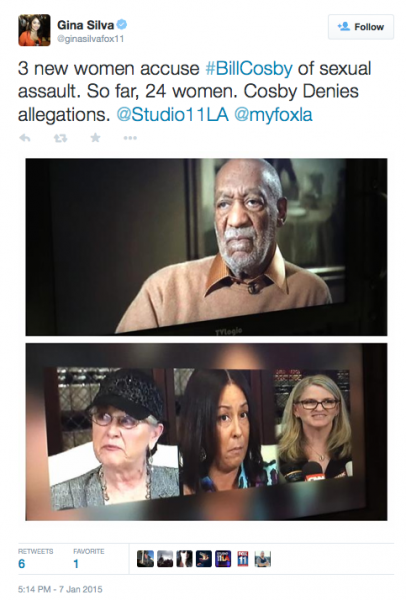What do media portrayals of Bill Cosby mean for prevention?
by: Fernando Quintero
posted on Thursday, January 08, 2015
“Oye, por ahi viene Bill Cosby!”
With salsa music playing over the opening credits and a male voice announcing in Spanish, “Hey, here comes Bill Cosby!” I thought The Cosby Show had finally come to represent the true diversity of our nation in the mid-90s.
He even introduced Latino characters to his show like Sonia Braga, the beautiful and talented — albeit oddly cast — Brazilian actress who played Mrs. Westlake, a high school teacher of Theo Huxtable, Cosby’s son on the show.
Despite the somewhat bland, squeaky-clean nature of his family comedy, I had gained a new respect for Cosby (save for his later, weird campaign on young black men-blaming).
I must admit that my initial reaction to recent allegations of sexual abuse by the veteran comedian was similar to many who grew up watching his shows (including my childhood favorite, the Saturday-morning cartoon series Fat Albert and The Cosby Kids). I felt incredulous. How could a man who had come to represent so many positive values around family, children and even racial and ethnic equality do such horrific things to so many women?
At Berkeley Media Studies Group, we’re asking — and currently researching — a much bigger, more important question: How do the media cover the issue of sexual violence and how does it impact the public conversation, and, ultimately, public policy? Working with the National Sexual Violence Resource Center, we are seeking to uncover the most effective ways to change the public conversation about sexual violence to include a prevention perspective.
To be sure, Cosby is the latest, and likely most tenable, lightning rod on the issue of sexual violence. With alleged victims, once hidden from view, continuing to come forth, as well as defenders (Phylicia Rashad, who played Cosby’s wife on The Cosby Show, this week told a reporter that claims against her TV husband must be “orchestrated”), the ongoing saga of drugging and rape accusations against the comedian will likely continue for weeks to come.

But how is media coverage of Cosby different — as well as similar — to other less visible stories of sexual and other types of violence against women? One key finding from our 2003 study of California newspaper coverage of intimate partner violence was that most of these cases went unreported. Readers saw only the most extreme cases.
Just as the absence of reporting about more typical intimate partner violence distorted the picture and made it more difficult to understand and address the problem, does that pattern continue today? And have we made any progress toward our goal of the news media including more of a focus on causes, intervention and prevention?
Our recent research on news coverage of child sexual abuse could also offer a glimpse into what we may find in current stories about sexual violence. Our 2011 report found that, similar to intimate partner violence, news coverage of child sexual abuse was infrequent. When it did occur, it was often tied to a “moment” in the criminal justice process. This resulted in scant coverage of prevention since most reports focused on an incident after the fact. We also found that language in stories about child sexual abuse was vague and imprecise, making it harder for readers to fully understand what really happened.
That same year, as with Cosby, there appeared one name that dominated news coverage of sexual abuse: former Penn State assistant football coach Jerry Sandusky. Following a two-year grand jury investigation, Sandusky was arrested and charged with 52 counts of sexual abuse against young boys. In June 2012, Sandusky was found guilty of 45 of the charges.
Among the findings in that report was that less than one-fifth of all stories examined discussed the impact of abuse and subsequent cover-up on the survivors — considerably less than the extensive coverage of the consequences faced by Sandusky as well as Penn State football coach Joe Paterno, university officials, and others.
When coverage includes more details about alleged perpetrators and less information about those experiencing abuse or violence, these stories may inadvertently provide a sympathetic portrayal of the accused. In the Sandusky coverage, we read about Paterno as a “legendary” and “beloved” football coach whose career had been tainted by the “scandal” brought on by his assistant, who was portrayed as a “monster in their midst.”
I have to wonder how Cosby will ultimately be portrayed. A fallen hero or a monster in our popular culture? More importantly, will his venerable celebrity status distract from the real issue at hand: How do we keep sexual assault from happening in the first place?



